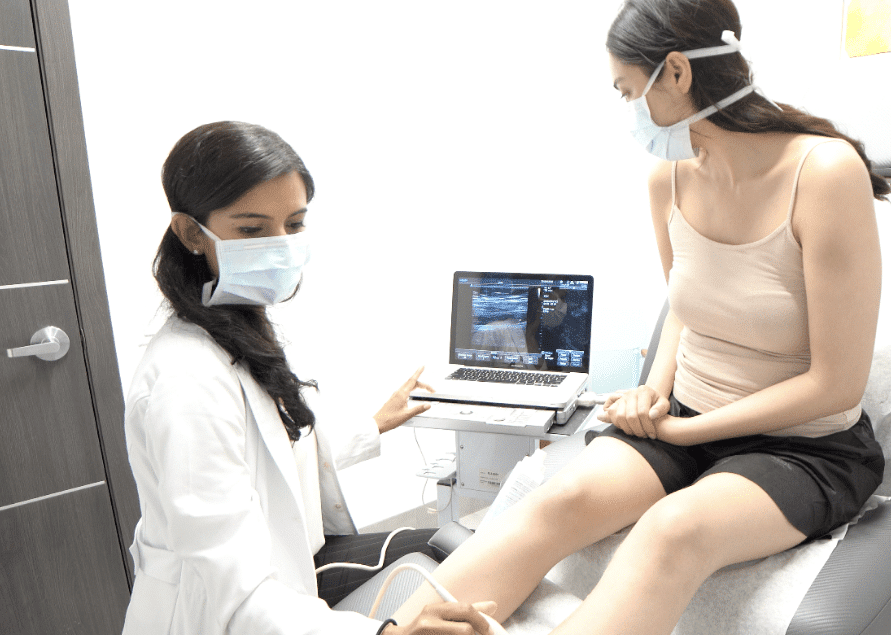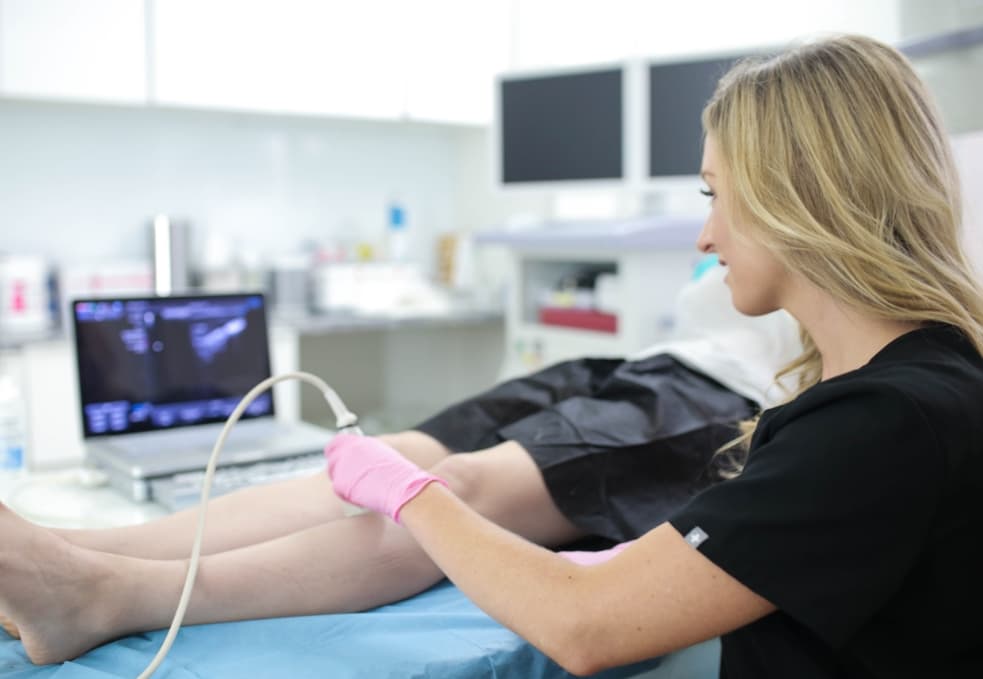Are you tired of dealing with unsightly spider veins that make you feel self-conscious about your legs? Maryland Vein Center is here to help you achieve smoother, healthier-looking skin through minimally invasive spider vein removal procedures. Led by board-certified vein doctors, we specialize in providing effective treatments that can restore your confidence and comfort. Schedule an appointment to eliminate spider veins and achieve smooth, healthy legs.

What Are Spider Veins?
Spider veins, also known as telangiectasia, are small, twisted blood vessels that appear close to the surface of the skin. They typically appear on the legs but can also occur on the face and other parts of the body. Spider veins are a common cosmetic concern, and while they are not usually painful or dangerous, they can cause discomfort and self-esteem issues.
Spider Veins Aren’t Always Cosmetic
While spider veins are commonly viewed as a cosmetic concern, it’s essential to recognize that they can sometimes be indicative of a more serious underlying condition known as chronic venous insufficiency (CVI). CVI is a medical condition in which the valves within the veins, primarily in the legs, become damaged, leading to impaired blood flow and pooling of blood in the lower extremities. This can manifest as a range of symptoms, including spider veins.
What is Chronic Venous Insufficiency?
In a healthy circulatory system, veins contain one-way valves that ensure blood flows upward toward the heart. These valves prevent the backward flow of blood and maintain efficient circulation. However, in individuals with chronic venous insufficiency, these valves become dysfunctional. As a result, blood can flow backward and accumulate in the lower extremities, causing increased pressure within the veins.
This elevated pressure contributes to the development of spider veins as the weakened vessels dilate and become visible beneath the skin’s surface. Moreover, the buildup of blood in the legs can lead to symptoms such as leg swelling, pain, and skin changes. Left untreated, CVI can progress to more severe conditions like varicose veins and even ulcers. Therefore, it’s crucial for individuals with spider veins to seek evaluation to rule out underlying venous insufficiency and receive appropriate treatment to address both cosmetic and potential health concerns.
Risk Factors for Spider Veins:
- Genetics: A family history of spider veins can increase your risk. If your parents or grandparents had spider veins, you may be genetically predisposed to this condition.
- Hormonal Changes: Hormonal fluctuations, such as during pregnancy, menopause, or as a result of birth control pills, can weaken vein walls and lead to the formation of spider veins.
- Prolonged Standing or Sitting: Occupations or activities that require long periods of standing or sitting can put extra pressure on the veins, increasing the risk.
- Age: As we age, our veins may lose elasticity, making them more susceptible to becoming visible beneath the skin’s surface.
- Obesity: Carrying excess weight places added pressure on the veins in your legs, which can lead to the formation of spider veins. Obesity can also contribute to other vein-related conditions, such as varicose veins and chronic venous insufficiency.
- Trauma or Injury: Injury or trauma to the skin or veins in your legs can increase the risk of spider veins. These injuries can damage the veins’ walls, increasing the risk of CVI.
How Spider Vein Removal Works
Maryland Vein Center offers several effective and minimally invasive treatments for spider vein removal. Let’s take a closer look at some of these procedures:
- Sclerotherapy: Sclerotherapy is widely used for spider veins. During this procedure, a special solution is injected directly into the affected veins, causing them to collapse and gradually fade away. Over time, your body absorbs the veins, resulting in smoother skin. Sclerotherapy is minimally invasive, virtually painless, and requires little to no downtime.
- Endovenous Laser Ablation (EVLA): Endovenous Laser Ablation, or EVLA, is a state-of-the-art technique used to treat larger spider veins and varicose veins. A laser fiber is inserted into the affected vein through a small incision. The laser energy heats and seals the vein, causing it to close off. Blood is then rerouted to healthier veins, and the treated vein is eventually reabsorbed by the body. EVLA is highly effective and minimally invasive, offering rapid relief from the discomfort caused by spider veins.
- Radiofrequency Ablation: RFA uses thermal energy to close off problematic veins. However, instead of a laser, radiofrequency energy is employed. Like other minimally invasive treatments, it requires minimal recovery time and produces excellent results.
- Ambulatory Phlebectomy: Ambulatory phlebectomy removes larger, bulging veins. It involves making tiny incisions near the affected veins and physically removing them through incisions. This procedure is performed with other treatments for comprehensive vein removal.
The Maryland Vein Center Difference:
- Personalized Treatment Plans: We understand that each patient is unique, and their spider veins may have different underlying causes. That’s why we start with a comprehensive evaluation that includes a duplex ultrasound to diagnose the root cause of your vein issues.
- Minimally Invasive Procedures: Our board-certified vein doctors specialize in minimally invasive procedures that are safe, effective, and virtually painless.
- Free Insurance Verification: Worried about the cost of spider vein removal? We offer free insurance verification to help you understand your coverage and financial options.
- Convenient Location: Our vein center is conveniently located at 10215 Fernwood Rd, Suite 301, Bethesda, Maryland, just outside of Washington, DC in Silver Spring, Maryland.
Preparing for Your Spider Vein Consultation
If you’re considering spider vein removal, the first step is to schedule a consultation with us. Here’s what you can expect during your consultation and how you can prepare:
- Medical History: During your initial consultation, we will review your medical history to gain a comprehensive understanding of your overall health.
- Examination: Our board-certified vein doctors will conduct a thorough physical examination, paying particular attention to the areas affected by spider veins.
- Duplex Ultrasound: In many cases, we will perform a duplex ultrasound to assess the health of your veins and identify any underlying issues. This non-invasive test uses sound waves to create images of your veins, allowing us to pinpoint problem areas.
- Questions and Concerns: Feel free to ask any questions or express concerns you may have during the consultation. We want you to feel comfortable with your treatment plan.
- Treatment Plan Discussion: Based on your medical history, examination, and any diagnostic tests, we will discuss the recommended treatment plan with you.
Aftercare and Recovery
Following your spider vein removal session, we will provide you with specific aftercare instructions to ensure a smooth recovery. Here are some general tips to keep in mind:
- Wear Compression Stockings: You may be advised to wear compression stockings to promote blood flow and reduce swelling. They help maintain the results of your treatment.
- Stay Active: Engaging in light physical activity, such as walking, to improve circulation and minimize the risk of blood clots. However, avoid strenuous exercise for a specified period.
- Follow Medication Instructions: If prescribed, take any medications as directed by your physician. These medications may help manage discomfort or prevent complications.
- Attend Follow-Up Appointments: It’s essential to attend all follow-up appointments to monitor your progress and address any concerns that may arise during your recovery.
FAQs about Spider Vein Removal
What are spider veins, and are they the same as varicose veins?
Spider veins are small, visible blood vessels that often appear on the legs, resembling spider webs or tree branches. While they are related to varicose veins, they are smaller and closer to the skin’s surface. Varicose veins are larger, swollen veins that can be painful.
How do I know which spider vein removal treatment is right for me?
The best treatment option depends on various factors, including the size and location of your spider veins, your overall health, and any underlying venous conditions. A consultation with one of our board-certified vein doctors will help determine the most suitable treatment plan.
Is spider vein removal painful?
Minimally invasive spider vein removal procedures, such as sclerotherapy and laser treatments, are typically well-tolerated and cause minimal discomfort. Most patients report only minor sensations, such as a mild burning or stinging.
Are the results of spider vein removal permanent?
Spider vein removal procedures are highly effective, and the results can be long-lasting. However, new spider veins may develop over time, so maintenance treatments may be necessary to maintain optimal results.
Visit Maryland Vein Center for Spider Vein Removal
Spider vein removal is a safe and effective way to regain confidence in your appearance and alleviate any discomfort caused by unsightly veins. At Maryland Vein Center, our board-certified vein doctors are dedicated to providing personalized, minimally invasive treatments that cater to your unique needs. Whether you opt for sclerotherapy, endovenous laser ablation, ClariVein, or ambulatory phlebectomy, you can trust us to deliver exceptional care and results. If you’re ready to take the first step toward smoother, healthier-looking skin, contact Maryland Vein Center today to schedule your consultation. Let us help you achieve the beautiful legs you deserve.





